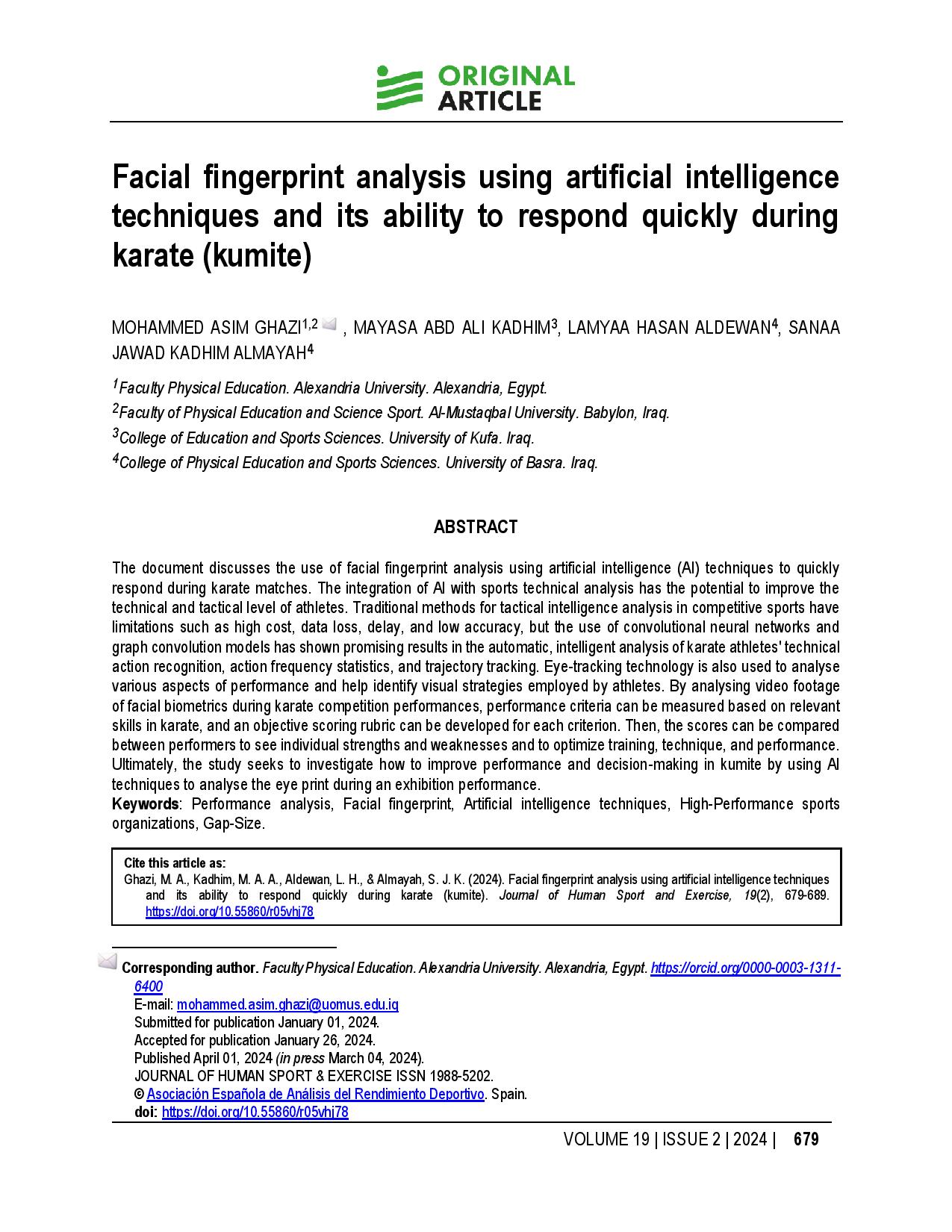Facial fingerprint analysis using artificial intelligence techniques and its ability to respond quickly during karate (kumite)
Main Article Content
Abstract
The document discusses the use of facial fingerprint analysis using artificial intelligence (AI) techniques to quickly respond during karate matches. The integration of AI with sports technical analysis has the potential to improve the technical and tactical level of athletes. Traditional methods for tactical intelligence analysis in competitive sports have limitations such as high cost, data loss, delay, and low accuracy, but the use of convolutional neural networks and graph convolution models has shown promising results in the automatic, intelligent analysis of karate athletes' technical action recognition, action frequency statistics, and trajectory tracking. Eye-tracking technology is also used to analyse various aspects of performance and help identify visual strategies employed by athletes. By analysing video footage of facial biometrics during karate competition performances, performance criteria can be measured based on relevant skills in karate, and an objective scoring rubric can be developed for each criterion. Then, the scores can be compared between performers to see individual strengths and weaknesses and to optimize training, technique, and performance. Ultimately, the study seeks to investigate how to improve performance and decision-making in kumite by using AI techniques to analyse the eye print during an exhibition performance.
Downloads
Article Details
Section

This work is licensed under a Creative Commons Attribution-NonCommercial-ShareAlike 4.0 International License.
Each author warrants that his or her submission to the Work is original and that he or she has full power to enter into this agreement. Neither this Work nor a similar work has been published elsewhere in any language nor shall be submitted for publication elsewhere while under consideration by Journal of Human Sport and Exercise (JHSE). Each author also accepts that the JHSE will not be held legally responsible for any claims of compensation.
Authors wishing to include figures or text passages that have already been published elsewhere are required to obtain permission from the copyright holder(s) and to include evidence that such permission has been granted when submitting their papers. Any material received without such evidence will be assumed to originate from the authors.
Please include at the end of the acknowledgements a declaration that the experiments comply with the current laws of the country in which they were performed. The editors reserve the right to reject manuscripts that do not comply with the abovementioned requirements. The author(s) will be held responsible for false statements or failure to fulfill the above-mentioned requirements.
This title is licensed under a Attribution-NonCommercial-ShareAlike 4.0 International (CC BY-NC-SA 4.0).
You are free to:
Share — copy and redistribute the material in any medium or format.
Adapt — remix, transform, and build upon the material.
The licensor cannot revoke these freedoms as long as you follow the license terms.
Under the following terms:
-
Attribution — You must give appropriate credit, provide a link to the license, and indicate if changes were made. You may do so in any reasonable manner, but not in any way that suggests the licensor endorses you or your use.
-
NonCommercial — You may not use the material for commercial purposes.
-
ShareAlike — If you remix, transform, or build upon the material, you must distribute your contributions under the same license as the original.
- No additional restrictions — You may not apply legal terms or technological measures that legally restrict others from doing anything the license permits.
Notices:
- You do not have to comply with the license for elements of the material in the public domain or where your use is permitted by an applicable exception or limitation.
- No warranties are given. The license may not give you all of the permissions necessary for your intended use. For example, other rights such as publicity, privacy, or moral rights may limit how you use the material.
How to Cite
References
Dicks, M. B. (2010). Examination of gaze behaviors under in situ and video simulation task constraints reveals differences in information pickup for perception and action. Atten. Percept. Psychophys. 72, 706-720. https://doi.org/10.3758/APP.72.3.706
Hyungkwan, S. S. (2012). User identification using face recognition for sports simulator. https://doi.org/10.1109/URAI.2012.6463067
Jianping, G. H. (2021). An Attention Enhanced Spatial-Temporal Graph Convolutional LSTM Network for Action Recognition in Karate. Applied Sciences. https://doi.org/10.3390/app11188641
Jun-Yao, Z. J. (2022). Video Tactical Intelligence Analysis Method of Karate Competition Based on Convolutional Neural Network. Discrete Dynamics in Nature and Society. https://doi.org/10.1155/2022/6204173
Katharina, P. N. (2019). Improvement of Early Recognition of Attacks in Karate Kumite Due to Training in Virtual Reality. https://doi.org/10.25299/sportarea.2019.vol4(2).3370
Keiichi, S. H. (2020). Commonality of Motions Having Effective Features with Respect to Methods for Identifying the Moves Made during Kumite Sparring in Karate. https://doi.org/10.5220/0010132400750082
Martins, A. O., Soares, P. M., Godinho, W. D. N., Serpa, G. L. de, & Silva, F. T. (2017). Dermatoglification Analysis for Selection and Training of Sports Talents. IOSR Journal of Pharmacy and Biological Sciences, 12(01), 79–83. https://doi.org/10.9790/3008-1201027983
Ripoll, H., Kerlirzin, Y., Stein, J.-F., & Reine, B. (1995). Analysis of information processing, decision making, and visual strategies in complex problem solving sport situations. Human Movement Science, 14(3), 325–349. https://doi.org/https://doi.org/10.1016/0167-9457(95)00019-O
Quan, W. S. (2014). Research on the Application of Motion Capture of Kinect Technology in the Sport Training. Advanced Materials Research. https://doi.org/10.4028/www.scientific.net/AMR.926-930.2714
Takaaki, K. (2020). Using "Enzan No Metsuke" (Gazing at the Far Mountain) as a Visual Search Strategy in Kendo. https://doi.org/10.3389/fspor.2020.00040
Williams, A. M. (1999). Anxiety, expertise, and visual search strategy in karate. J. Sport Exerc. Psychol. 21, 362-375. https://doi.org/10.1123/jsep.21.4.362
Yan, L. C. (2014). The Key Technology Research of Kinect Application in Sport Training. Advanced Materials Research. https://doi.org/10.4028/www.scientific.net/AMR.945-949.1890




